- 公告
- 展览
- 讲座
- 笔会
- 拍卖
- 活动



异化景观:朱离子格作品展
策展人:吴鸿
展览时间:2018年8月18日至2018年9月18日
开幕时间:2018年8月18日(周六)下午4点
展览地点:艺术国际美术馆
地 址:北京市通州区宋庄艺术区小堡北街205号
Alienated Landscapes: Zhu Lizige
Curator: Wu Hong
Exhibition Dates: August 18, 2018 to September 18, 2018
Opening: August 18, 2018, 4 PM
Venue: Artintern Art Museum
Address: No. 205 Xiaopu North Street, Songzhuang Art District, Tongzhou District, Beijing


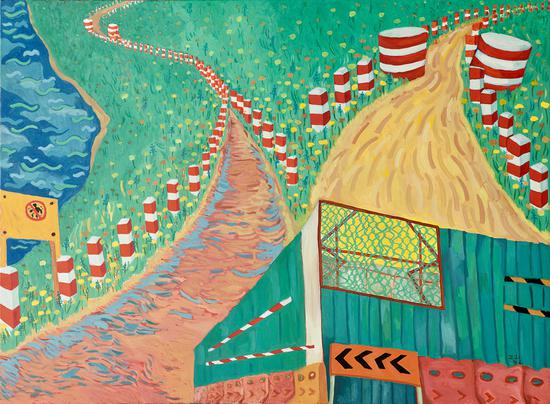
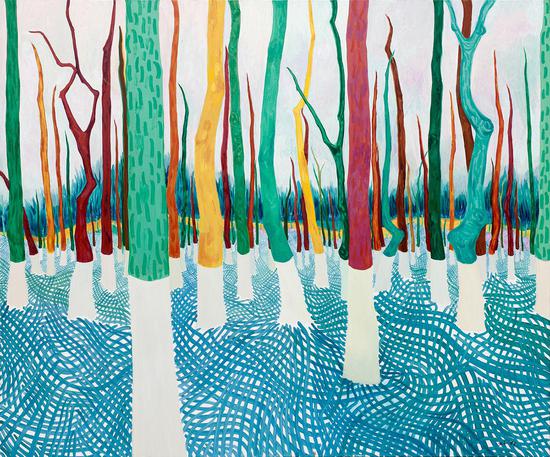
被操控的符码:朱离子格作品中的异化景观
吴鸿
正如电影《楚门的世界》中所揭示的那样,人类越来越近似于生活在一个虚构的“世界”中,只不过是,楚门生活的桃源岛小城是一座由人工构建而成的巨大摄影棚。也就是说,楚门每天所看到的世界仍然脱离不了它的“实物”替代性的特征。而在《黑客帝国》中,这种实物替代性让位于数字代码,网络黑客尼奥所生活的世界已经不再是由实体物质虚构替代而成,反之,在矩阵空间中,世界万物和感性知觉,乃至于构成世界的世界观,都是由无形的数字代码虚拟而成。也就是说,在《楚门的世界》里主体性依然是建立在客观性的基础上,而在《黑客帝国》中,主体性则是由主观性所建构出来的。或者说,尼奥们的主体感知性是由系统母体所设定的。即便如此,在建构了桃源岛的制片人和建构了矩阵的母体之间,其二者的意义同构性还是显而易见的。首先,他(它)们都是全知全觉者,对于被他(它)们所创造出来的子系统而言,他(它)们是上一级系统,故而,上一级系统的存在性可以覆盖下一级系统。所以,对于子系统的存在意义而言,他(它)们相当于就是“根目录”,删除了根目录也就意味着删除了其下的所有子系统。其次,他(它)们不仅是被创造物的创造者,也是操纵者。其操纵过程已经不再是传统的暴力机器和行政手段,而是转变成为符号和代码,以及编织这些符号和代码使之产生意义的逻辑系统和意识形态。
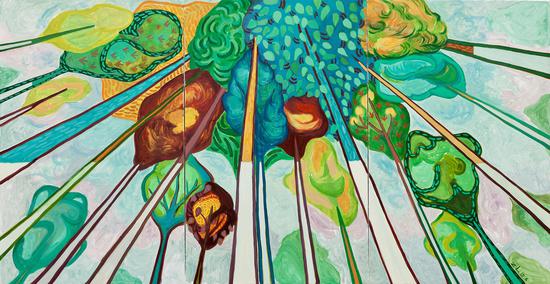
这实际上也符合鲍德里亚所提出的拟像理论。在当代社会,“拟像和仿真的东西因为大规模地类型化而取代了真实和原初的东西,世界因而变得拟像化了”。鲍德里亚认为拟像不再是对某个领域、某种指涉对象或某种实体的模拟,它无需原物或者实体,而是通过模型来生产真实。这种真实被鲍德里亚称为“超真实”(hyperreality)。虽然鲍德里亚的拟像理论主要针对的是大众媒介在构成后现代社会中的作用的反思,但是,对于后现代社会现实中由符码构成的异化景观的分析,鲍德里亚的理论仍然有其平行位移式的价值。
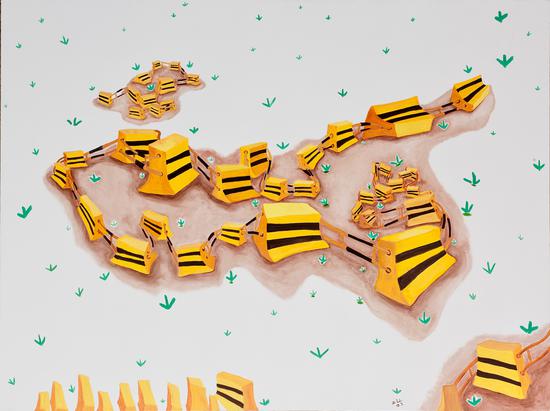
艺术家朱离子格的作品即是揭示了在后现代“信息-消费”社会中,符码、符码的操控性,以及它们与真实之间的关系。交通标志、建筑彩条布、铁丝网,以及刷涂了石灰水的树干,这些都构成了一种强制性的视觉倾向性。它们或遮盖、或涂抹、或阻隔了“现实”与真相之间的关系,并且自身形成了一种新的意义编码系统,从而成为了类似于鲍德里亚笔下的“超真实”(hyperreality)。后现代社会中的各种符码构成了可以取代了真实和原初的意义系统,又由这些意义系统形成了普遍的世界观和价值观,并进而由这种普遍的世界观和价值观操控着个体。问题是,又是谁来操控着这些看似“合理”的符码编织逻辑呢?是桃源岛小城的“制片人”?还是矩阵中虚无的“母体”?或许这些都不重要,重要的是他(它)们已经成为了决定我们存在意义的“根目录”。也就是说,如果一旦删除了这些“根目录”,我们就成为了漂浮在虚无中的意义碎片。人类就又重新回到了那个意义的原点:“本源”成为一种拟像,幻觉与现实混淆,现实不存在了,没有现实坐标的确证——人类不知何所来、何所去……
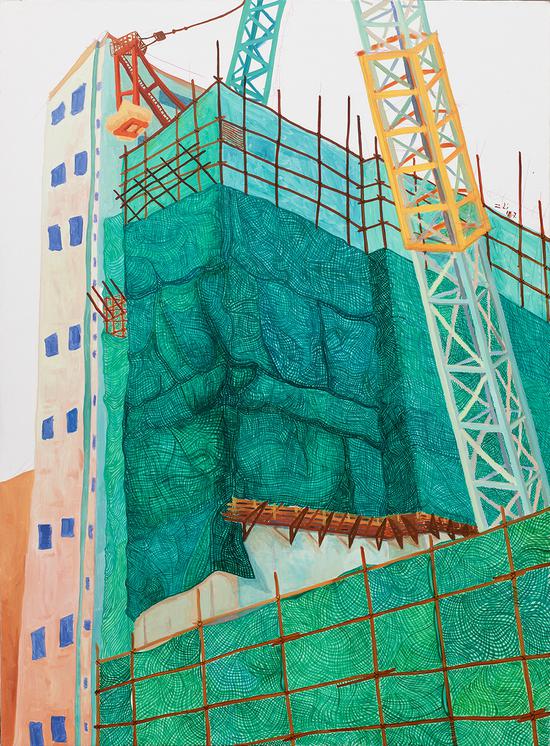
或许,我们还可以把朱离子格的作品视为一种依附在后现代图景中的“风景画”。但是,这实际上是一种残忍的类比。重新回到鲍德里亚的拟像理论:鲍德里亚为后现代的文化设立了一个坐标系,他认为拟像的第一个序列时期是仿造(counterfeit),仿造是从文艺复兴到工业革命时期的主导模式,这一序列的类像遵循“自然价值规律”,也就是承袭了亚历士多德以来的“模拟说”,这一时期的仿真追求的是模拟、复制自然和反映自然。这里可以对应为早期资本主义的温情的岸树和远霭,以及夕阳下的白裙少女。而在拟像的第三个序列是仿真(simulation),这是被符码所主宰的后现代社会的主导模式。这一阶段拟像创造了“超真实”,传统的表现“真实”的规律被打破,模型构成了真实,其结果便是真实之死。所以说,朱离子格表现的不再是“自然”、“真实”的风景,而是体现了人工的、符码化的、异化了的后现代社会景观。

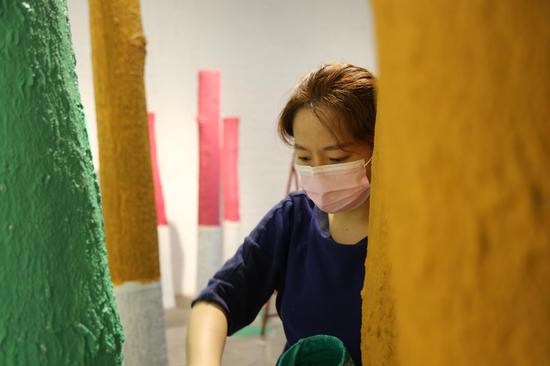
这种后现代社会景观也不再是独立于主体之外的客体,而是一种主体的镜像。它是主体意志的客体化和符码化。或言之,当主体亦是某种主观意识的客体化的时候,异化的景观便成为这个时代的集体无意识的象征。
2018年8月7日 于北京
(吴鸿:策展人、评论家,艺术国际主编,宋庄当代艺术文献馆执行馆长,吉林艺术学院客座教授、研究生导师)
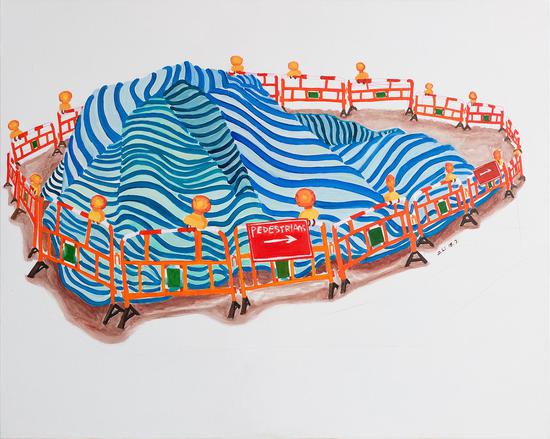
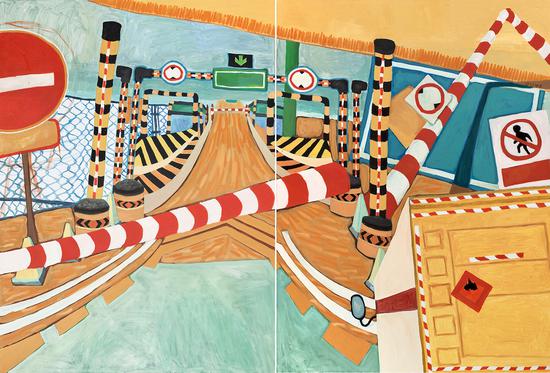
Manipulated Code: The Alienated Landscapes in Zhu Ligezi’s Work
Wu Hong
Humanity is approaching life in a fabricated “world,” like inThe Truman Show;the key was that the utopian town in which Truman lived was a giant film set built by other people. The world that Truman saw everyday still requiredthe substitution of material objects. In The Matrix,the substitution of physical objects gives way to digital code; the world in whichNeo lives is not fabricated from an assemblage of physical objects. Instead, in the space of the matrix, everything in the world, all sensory perceptions, and even the world view that shapes all of this were the virtual creations of intangible digital codes.InThe Truman Show, the subject is still constructed on a foundation of objectivity, but inThe Matrix, the subject is constructed from subjectivity. Or one might say thatNeo’s subjective perceptions were defined by the system matrix. Despite this, the similar ways in which the producers who built the utopia and the generators of the matrix construct meaning are obvious. First, they are all-knowing and all-seeing, and they are a level above the subsystem that they have created. Therefore, the existence of the higher-level system can envelop that of the lower-level system, so in the existence of the subsystem, they are equivalent to the root directory.Deleting the root directory implies deleting all subsystemsunder it. Second, they are the creators of their creations, but they are also the manipulators of their creations. This process of manipulation is no longer confined totraditional violent means and administrative measures; this manipulation is transformed into symbols and codes,which are woven together to produce a logical system and ideology related to meaning.
This actually fits with Jean Baudrillard’s theory of simulation and simulacra. In the grand typologies of contemporary society,simulations and simulacra have replaced the real and the original, and the world thereby becomes simulated. Baudrillard believed that “simulation is no longer that of a territory, a referential being, or a substance. It is the generation by models of a real without original or reality.”[1]Baudrillardcalled this “hyperreality.”Baudrillard’s theory of simulations and simulacra is primarily a reflection of the role of the mass media in constructing post-modernsociety, but his theory still has a parallel applicationin an analysis of the alienated landscapes constructed of code in a post-modern social reality.
Zhu Lizige’s work reveals the relationships between code, the manipulation of code, and truthin a post-modern “information-consumption” society. Traffic signs, striped building tarps,chain link fences, and tree trunks painted with limestonestripesare imposed visual elements. They cover,erase, or obliterate the relationship between “reality”and the truth,and form a new coding system for meaning, becoming something akin to Baudrillard’s hyperreality. Various codes in post-modern society make up a system of meaning that can replace origins and realities, and these systems of meaning can make up common worldviews and values systems, thereby controlling the individual. The question is: who is manipulating the seemingly rational logic behind these codes? Is it the producer of that utopian town? Or theworld inside the matrix? Perhaps all of this is not important; what is important is that they have already become the root directories that determine our existential meaning. Once these root directories are deleted, we become fragments of meaning floating in nothingness. Humanity has returned to the origin of that meaning. The origin becomes a simulacrum, illusion and reality are mixed, reality does not exist, and there is no concrete proof of real coordinates. Humanity does not know where it came from or where it is going…
We could still see Zhu Lizige’s work as “landscape paintings”dependent on post-modernvisions.However,the comparison to landscape painting is actually a bit harsh. Let us return to Baudrillard’s theory. He set a coordinate system for post-modern culture; he believed that the first order process was counterfeiting, a leading model from the Renaissance to the Industrial Revolution. This process follows “natural laws of value,”and adopts the idea of mimesis that began with Aristotle. At this stage, counterfeiting intended to imitate, replicate, and reflect nature. This could correspond to the sentimental early capitalist depictions of mist and trees on the opposite shoreand a girl in a white dress in the setting sun.The third order is a simulacrum, which is the leading model for a post-modern society governed by code.In this state, the simulacrumcreates hyperreality. Traditional ways of expressing “reality” are broken, and models create reality. The result is the death of reality. That is to say, what Zhu Lizige presents is no longer a “natural” and “real” landscape; it is an artificial, symbolic, and alienated post-modern societal landscape.
This post-modern societal landscape is no longer an object independent of the subject; it’s a mirror image of the subject, the objectification and codification of subjective will. In other words, when the subject becomes the objectification of a subjective consciousness, alienated landscapes become symbols of the collective unconscious of this era.
August 7, 2018, Beijing
(Wu Hong: Art critic, curator, editor-in-chief of Artintern.net, managing director of the Songzhuang Contemporary Art Archive, and a guest professor and graduate advisor at Jilin College of the Arts)
References
Baudrillard, Jean. Simulacra and Simulation. Ann Arbor: University of Michigan Press, 1994.
[1] Jean Baudrillard, Simulacra and Simulation (Ann Arbor: University of Michigan Press, 1994), 1.

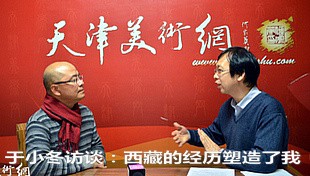
 赵国经、王美芳
¥ 0
赵国经、王美芳
¥ 0
 王学仲:《垂杨饮马》
¥ 0
王学仲:《垂杨饮马》
¥ 0
 何家英:《醉艳》
¥ 0
何家英:《醉艳》
¥ 0
 萧朗:难忘十月醉金秋
¥ 0
萧朗:难忘十月醉金秋
¥ 0